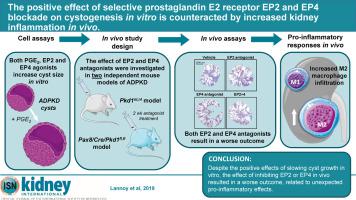Kidney International ( IF 14.8 ) Pub Date : 2020-03-06 , DOI: 10.1016/j.kint.2020.02.012 Morgane Lannoy 1 , Manoj K Valluru 1 , Lijun Chang 1 , Fatima Abdela-Ali 1 , Dorien J M Peters 2 , Andrew J Streets 1 , Albert C M Ong 1

|
Autosomal Dominant Polycystic Kidney Disease (ADPKD) is a major cause of end-stage kidney disease in man. The central role of cyclic adenosine monophosphate (cAMP) in ADPKD pathogenesis has been confirmed by numerous studies including positive clinical trial data. Here, we investigated the potential role of another major regulator of renal cAMP, prostaglandin E2 (PGE2), in modifying disease progression in ADPKD models using selective receptor modulators to all four PGE2 receptor subtypes (EP1-4). In 3D-culture model systems utilizing dog (MDCK) and patient-derived (UCL93, OX161-C1) kidney cell lines, PGE2 strikingly promoted cystogenesis and inhibited tubulogenesis by stimulating proliferation while reducing apoptosis. The effect of PGE2 on tubulogenesis and cystogenesis in 3D-culture was mimicked or abolished by selective EP2 and EP4 agonists or antagonists but not those specific to EP1 or EP3. In a Pkd1 mouse model (Pkd1nl/nl), kidney PGE2 and COX-2 expression were increased by two-fold at the peak of disease (week four). However, Pkd1nl/nl mice treated with selective EP2 (PF-04418948) or EP4 (ONO-AE3-208) antagonists from birth for three weeks had more severe cystic disease and fibrosis associated with increased cell proliferation and macrophage infiltration. A similar effect was observed for the EP4 antagonist ONO-AE3-208 in a second Pkd1 model (Pax8rtTA-TetO-Cre-Pkd1f/f). Thus, despite the positive effects of slowing cyst growth in vitro, the more complex effects of inhibiting EP2 or EP4 in vivo resulted in a worse outcome, possibly related to unexpected pro-inflammatory effects.
中文翻译:

选择性前列腺素E2受体EP2和EP4阻断对体外囊肿发生的积极作用被体内肾脏炎症增加所抵消。
常染色体显性多囊肾病(ADPKD)是人类终末期肾脏疾病的主要原因。包括阳性临床试验数据在内的众多研究证实了环磷酸一磷酸腺苷(cAMP)在ADPKD发病机理中的核心作用。在这里,我们调查了肾脏cAMP的另一种主要调节剂前列腺素E 2(PGE 2)在使用选择性受体调节剂对所有四种PGE 2受体亚型(EP1-4)修饰ADPKD模型中疾病进展中的潜在作用。在利用狗(MDCK)和患者来源(UCL93,OX161-C1)肾细胞系的3D培养模型系统中,PGE 2通过刺激增殖并减少细胞凋亡,显着促进了囊肿形成并抑制了微管形成。通过选择性的EP2和EP4激动剂或拮抗剂(但不是对EP1或EP3特异的拮抗剂),可以模仿或消除PGE 2对3D培养中的肾小管生成和囊肿生成的影响。在Pkd1小鼠模型(Pkd1 nl / nl)中,肾脏PGE 2和COX-2表达在疾病高峰期(第4周)增加了两倍。但是,Pkd1 nl / nl出生时用选择性EP2(PF-04418948)或EP4(ONO-AE3-208)拮抗剂治疗三周的小鼠患有更严重的囊性疾病和纤维化,与细胞增殖和巨噬细胞浸润增加有关。在第二个Pkd1模型中(Pax8rtTA-TetO-Cre-Pkd1 f / f),对EP4拮抗剂ONO-AE3-208观察到了类似的效果。因此,尽管在体外减缓囊肿生长有积极作用,但在体内抑制EP2或EP4的更为复杂的作用却导致更糟的结果,可能与意想不到的促炎作用有关。











































 京公网安备 11010802027423号
京公网安备 11010802027423号